Shape Sublayer in .NET MAUI Maps (SfMaps)
7 Jan 202524 minutes to read
The shape sublayer is where geographical rendering will happen for the sublayer. This is similar to the main MapShapeLayer rendering. This section explains adding a shape sublayer on the shape layer.
To learn more about the .NET MAUI Maps shape sub layer, you can check the following video.
Shape sublayer on tile layer
The Sublayers in MapTileLayer contains collection of MapSublayer.The actual geographical rendering is done in the each MapShapeSublayer. The ShapesSource property of the MapShapeSublayer is of type MapSource. The path of the .json file which contains the GeoJSON data has to be set to the ShapesSource.
The ShapeDataField property of the ShapesSource is used to refer the unique field name in the .json file to identify each shapes.
<maps:SfMaps>
<maps:SfMaps.Layer>
<maps:MapTileLayer UrlTemplate="https://tile.openstreetmap.org/{z}/{x}/{y}.png">
<maps:MapTileLayer.Sublayers>
<maps:MapShapeSublayer ShapesSource="https://cdn.syncfusion.com/maps/map-data/africa.json"
ShapeStroke="DarkGrey"
ShapeFill="#c6c6c6">
</maps:MapShapeSublayer>
</maps:MapTileLayer.Sublayers>
</maps:MapTileLayer>
</maps:SfMaps.Layer>
</maps:SfMaps>SfMaps map = new SfMaps();
MapTileLayer tileLayer = new MapTileLayer();
tileLayer.UrlTemplate = "https://tile.openstreetmap.org/{z}/{x}/{y}.png";
MapShapeSublayer sublayer = new MapShapeSublayer();
sublayer.ShapesSource = MapSource.FromUri(new Uri("https://cdn.syncfusion.com/maps/map-data/africa.json"));
sublayer.ShapeFill = Color.FromRgb(198, 198, 198);
sublayer.ShapeStroke = Colors.DarkGrey;
tileLayer.Sublayers.Add(sublayer);
map.Layer = tileLayer;
this.Content = map;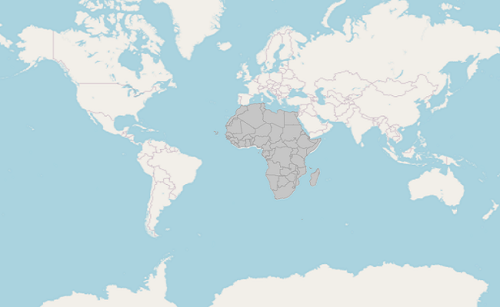
NOTE
- Refer the
MapTileLayer, for adding tile layer inSfMaps.
Shape sublayer on shape layer
The Sublayers in MapShapeLayer contains collection of MapSublayer.The actual geographical rendering is done in the each MapShapeSublayer. The ShapesSource property of the MapShapeSublayer is of type MapSource. The path of the .json file which contains the GeoJSON data has to be set to the ShapesSource.
The ShapeDataField property of the ShapesSource is used to refer the unique field name in the .json file to identify each shapes.
<map:SfMaps>
<map:SfMaps.Layer>
<map:MapShapeLayer ShapesSource="https://cdn.syncfusion.com/maps/map-data/world-map.json">
<map:MapShapeLayer.Sublayers>
<map:MapShapeSublayer ShapesSource="https://cdn.syncfusion.com/maps/map-data/africa.json" />
</map:MapShapeLayer.Sublayers>
</map:MapShapeLayer>
</map:SfMaps.Layer>
</map:SfMaps>SfMaps maps = new SfMaps();
MapShapeLayer layer = new MapShapeLayer();
layer.ShapesSource = MapSource.FromUri(new Uri("https://cdn.syncfusion.com/maps/map-data/world-map.json"));
MapShapeSublayer sublayer = new MapShapeSublayer();
sublayer.ShapesSource = MapSource.FromUri(new Uri("https://cdn.syncfusion.com/maps/map-data/africa.json"));
sublayer.ShapeFill = Color.FromRgb(198, 198, 198);
sublayer.ShapeStroke = Colors.DarkGrey;
layer.Sublayers.Add(sublayer);
maps.Layer = layer;
this.Content = maps;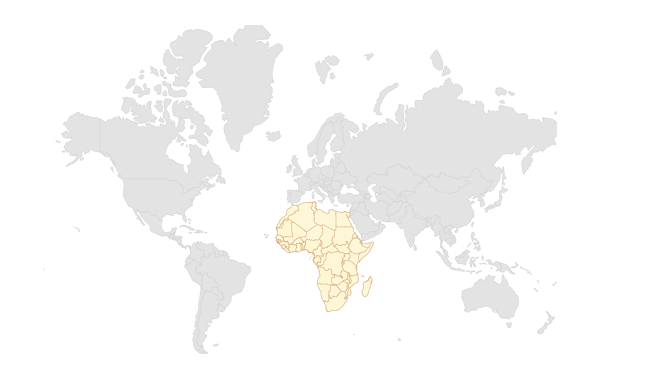
NOTE
Refer the
MapShapeLayer, for adding shape layer inSfMaps.
Color and stroke color
You can change the color, stroke color and stroke thickness of the shape sublayer using the ShapeFill, ShapeStroke and ShapeStrokeThickness properties.
<map:SfMaps>
<map:SfMaps.Layer>
<map:MapShapeLayer ShapesSource="https://cdn.syncfusion.com/maps/map-data/world-map.json">
<map:MapShapeLayer.Sublayers>
<map:MapShapeSublayer ShapeStroke="#226ac1"
ShapeFill="#bbdefa"
ShapesSource="https://cdn.syncfusion.com/maps/map-data/africa.json" />
</map:MapShapeLayer.Sublayers>
</map:MapShapeLayer>
</map:SfMaps.Layer>
</map:SfMaps>SfMaps maps = new SfMaps();
MapShapeLayer layer = new MapShapeLayer();
layer.ShapesSource = MapSource.FromUri(new Uri("https://cdn.syncfusion.com/maps/map-data/world-map.json"));
MapShapeSublayer sublayer = new MapShapeSublayer();
sublayer.ShapesSource = MapSource.FromUri(new Uri("https://cdn.syncfusion.com/maps/map-data/africa.json"));
sublayer.ShapeFill = Color.FromRgb(187, 222, 250);
sublayer.ShapeStroke = Color.FromRgb(34, 106, 193);
layer.Sublayers.Add(sublayer);
maps.Layer = layer;
this.Content = maps;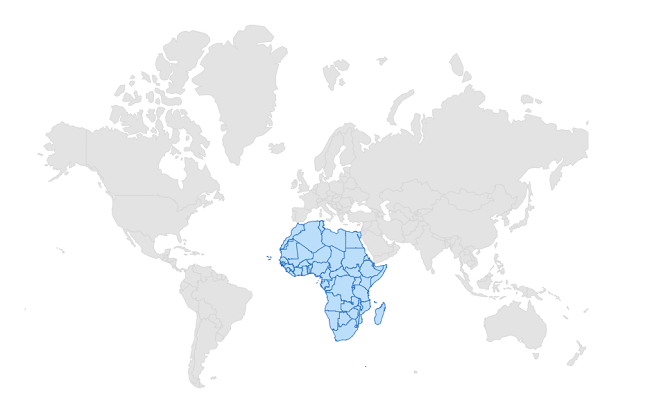
Equal color mapping
You can apply color to the sublayer shape by comparing a value from the ColorMappings with the EqualColorMapping.Value. For the matched values, the EqualColorMapping.color will be applied to the respective shapes.
<map:SfMaps>
<map:SfMaps.Layer>
<map:MapShapeLayer ShapesSource="https://cdn.syncfusion.com/maps/map-data/world-map.json">
<map:MapShapeLayer.Sublayers>
<map:MapShapeSublayer ShapesSource="https://cdn.syncfusion.com/maps/map-data/africa.json"
ShapeStroke="DarkGrey"
ShapeFill="#c6c6c6"
ShapeDataField="name"
PrimaryValuePath="State"
ShapeColorValuePath="Storage">
<map:MapShapeSublayer.ColorMappings>
<map:EqualColorMapping Color="Red"
Value="Low" />
<map:EqualColorMapping Color="Green"
Value="High" />
</map:MapShapeSublayer.ColorMappings>
</map:MapShapeSublayer>
</map:MapShapeLayer.Sublayers>
</map:MapShapeLayer>
</map:SfMaps.Layer>
</map:SfMaps>public MainPage()
{
InitializeComponent();
ViewModel viewModel = new ViewModel();
this.BindingContext = viewModel;
SfMaps maps = new SfMaps();
MapShapeLayer layer = new MapShapeLayer();
layer.ShapesSource = MapSource.FromUri(new Uri("https://cdn.syncfusion.com/maps/map-data/world-map.json"));
MapShapeSublayer sublayer = new MapShapeSublayer();
sublayer.ShapesSource = MapSource.FromUri(new Uri("https://cdn.syncfusion.com/maps/map-data/africa.json"));
sublayer.ShapeFill = Color.FromRgb(198, 198, 198);
sublayer.ShapeStroke = Colors.DarkGrey;
sublayer.DataSource = viewModel.Data;
sublayer.PrimaryValuePath = "State";
sublayer.ShapeDataField = "name";
sublayer.ShapeColorValuePath = "Storage";
EqualColorMapping colorMapping = new EqualColorMapping();
colorMapping.Color = Colors.Red;
colorMapping.Value = "Low";
EqualColorMapping colorMapping1 = new EqualColorMapping();
colorMapping1.Color = Colors.Green;
colorMapping1.Value = "High";
sublayer.ColorMappings.Add(colorMapping);
sublayer.ColorMappings.Add(colorMapping1);
layer.Sublayers.Add(sublayer);
maps.Layer = layer;
this.Content = maps;
}
public class ViewModel
{
public ObservableCollection<Model> Data { get; set; }
public ViewModel()
{
Data = new ObservableCollection<Model>();
Data.Add(new Model("Algeria", "Low"));
Data.Add(new Model("Nigeria", "High"));
Data.Add(new Model("Libya", "High")); ;
}
}
public class Model
{
public String State { get; set; }
public String Storage { get; set; }
public Model(string state, string storage)
{
State = state;
Storage = storage;
}
}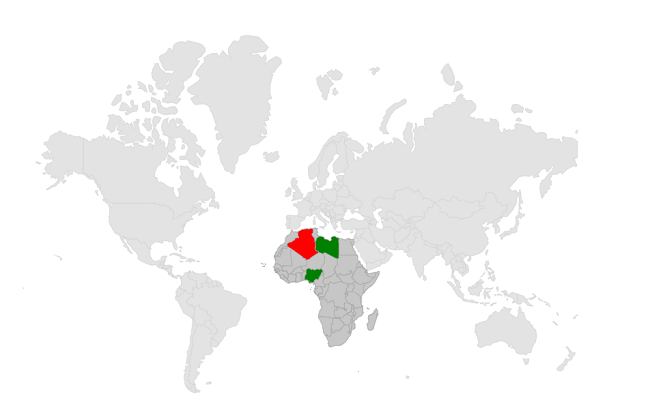
Range color mapping
You can apply color to the sublayer shapes based on whether the value from ColorMappings falls within the RangeColorMapping.From and RangeColorMapping.To. Then, the RangeColorMapping.Color will be applied to the respective shapes.
<map:SfMaps>
<map:SfMaps.Layer>
<map:MapShapeLayer ShapesSource="https://cdn.syncfusion.com/maps/map-data/world-map.json">
<map:MapShapeLayer.Sublayers>
<map:MapShapeSublayer ShapesSource="https://cdn.syncfusion.com/maps/map-data/africa.json"
ShapeStroke="DarkGrey"
ShapeFill="#c6c6c6"
ShapeDataField="name"
PrimaryValuePath="State"
ShapeColorValuePath="Count">
<map:MapShapeSublayer.ColorMappings>
<map:RangeColorMapping Color="Red"
From="0" To="100" />
<map:RangeColorMapping Color="Green"
From="101" To="300" />
</map:MapShapeSublayer.ColorMappings>
</map:MapShapeSublayer>
</map:MapShapeLayer.Sublayers>
</map:MapShapeLayer>
</map:SfMaps.Layer>
</map:SfMaps>public MainPage()
{
InitializeComponent();
ViewModel viewModel = new ViewModel();
this.BindingContext = viewModel;
SfMaps maps = new SfMaps();
MapShapeLayer layer = new MapShapeLayer();
layer.ShapesSource = MapSource.FromUri(new Uri("https://cdn.syncfusion.com/maps/map-data/world-map.json"));
MapShapeSublayer sublayer = new MapShapeSublayer();
sublayer.ShapesSource = MapSource.FromUri(new Uri("https://cdn.syncfusion.com/maps/map-data/africa.json"));
sublayer.ShapeFill = Color.FromRgb(198, 198, 198);
sublayer.ShapeStroke = Colors.DarkGrey;
sublayer.DataSource = viewModel.Data;
sublayer.PrimaryValuePath = "State";
sublayer.ShapeDataField = "name";
sublayer.ShapeColorValuePath = "Count";
RangeColorMapping colorMapping = new RangeColorMapping();
colorMapping.Color = Colors.Red;
colorMapping.From = 0;
colorMapping.To = 100;
RangeColorMapping colorMapping1 = new RangeColorMapping();
colorMapping.Color = Colors.Green;
colorMapping.From = 101;
colorMapping.To = 300;
sublayer.ColorMappings.Add(colorMapping);
sublayer.ColorMappings.Add(colorMapping1);
layer.Sublayers.Add(sublayer);
maps.Layer = layer;
this.Content = maps;
}
public class ViewModel
{
public ObservableCollection<Model> Data { get; set; }
public ViewModel()
{
Data = new ObservableCollection<Model>();
Data.Add(new Model("Algeria", 196));
Data.Add(new Model("Nigeria", 280));
Data.Add(new Model("Libya", 45));
}
}
public class Model
{
public String State { get; set; }
public double Count { get; set; }
public Model(string state, double count)
{
State = state;
Count = count;
}
}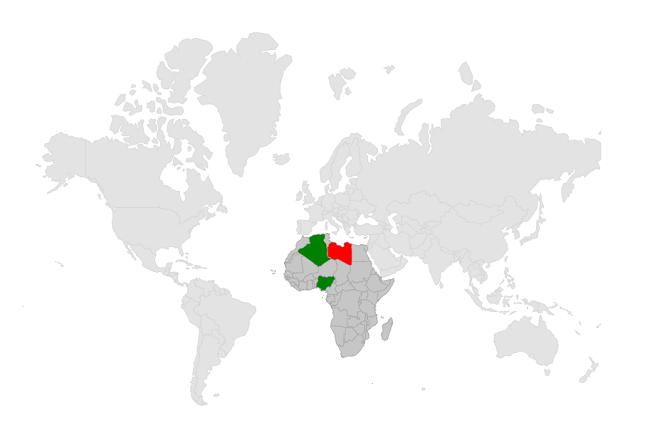
Enable data labels and its customization
You can enable data labels to the shape sublayer using the ShowDataLabels and DataLabelPath properties. The ShowDataLabels is used to control the visibility of data labels, the DataLabelPath is used to decide which underline property has to be displayed as data labels. The default value of ShowDataLabels is false.
<map:SfMaps>
<map:SfMaps.Layer>
<map:MapShapeLayer ShapesSource="https://cdn.syncfusion.com/maps/map-data/world-map.json">
<map:MapShapeLayer.Sublayers>
<map:MapShapeSublayer ShapesSource="https://cdn.syncfusion.com/maps/map-data/africa.json"
ShapeStroke="DarkGrey"
ShapeFill="#c6c6c6"
ShapeDataField="name"
PrimaryValuePath="State"
ShowDataLabels="True">
<map:MapShapeSublayer.DataLabelSettings>
<map:MapDataLabelSettings DataLabelPath="State" >
<map:MapDataLabelSettings.DataLabelStyle>
<map:MapLabelStyle FontSize="6"
TextColor="#ff4e41"
FontAttributes="Bold" />
</map:MapDataLabelSettings.DataLabelStyle>
</map:MapDataLabelSettings>
</map:MapShapeSublayer.DataLabelSettings>
</map:MapShapeSublayer>
</map:MapShapeLayer.Sublayers>
</map:MapShapeLayer>
</map:SfMaps.Layer>
</map:SfMaps>public SublayerDataLabels()
{
InitializeComponent();
ViewModel viewModel = new ViewModel();
this.BindingContext = viewModel;
SfMaps maps = new SfMaps();
MapShapeLayer layer = new MapShapeLayer();
layer.ShapesSource = MapSource.FromUri(new Uri("https://cdn.syncfusion.com/maps/map-data/world-map.json"));
MapShapeSublayer sublayer = new MapShapeSublayer();
sublayer.ShapesSource = MapSource.FromUri(new Uri("https://cdn.syncfusion.com/maps/map-data/africa.json"));
sublayer.ShapeFill = Color.FromRgb(198, 198, 198);
sublayer.ShapeStroke = Colors.DarkGray;
sublayer.DataSource = viewModel.Data;
sublayer.PrimaryValuePath = "State";
sublayer.ShapeDataField = "name";
sublayer.ShowDataLabels = true;
sublayer.DataLabelSettings = new MapDataLabelSettings()
{
DataLabelPath = "State",
DataLabelStyle = new MapLabelStyle()
{
FontSize = 6,
FontAttributes = FontAttributes.Bold,
TextColor = Color.FromRgb(255, 78, 65)
},
};
layer.Sublayers.Add(sublayer);
maps.Layer = layer;
this.Content = maps;
}
public class ViewModel
{
public ObservableCollection<Model> Data { get; set; }
public ViewModel()
{
Data = new ObservableCollection<Model>();
Data.Add(new Model("Algeria", Colors.Green));
Data.Add(new Model("Libya", Colors.Teal));
Data.Add(new Model("Egypt", Colors.Blue));
Data.Add(new Model("Niger", Colors.Indigo));
Data.Add(new Model("Nigeria", Colors.MediumPurple));
Data.Add(new Model("Chad", Colors.LightGreen));
Data.Add(new Model("Sudan", Colors.IndianRed));
Data.Add(new Model("Mauritania", Colors.Orange));
Data.Add(new Model("South Sudan", Colors.Lime));
Data.Add(new Model("Ethiopia", Colors.GreenYellow));
}
}
public class Model
{
public String State { get; set; }
public Color Color { get; set; }
public Model(string state, Color color)
{
State = state;
Color = color;
}
}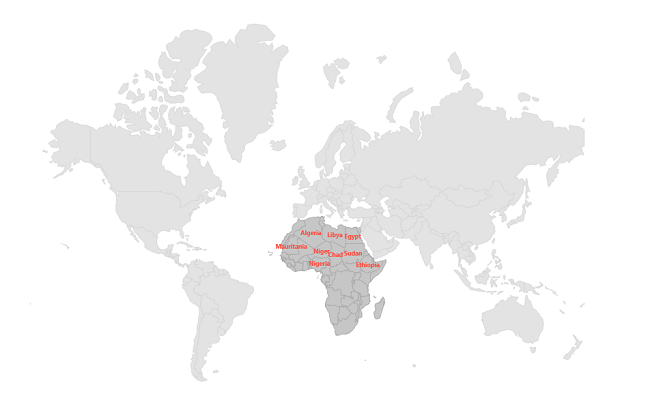
Add bubbles to the sublayer
You can enable bubbles to the shape sublayer using the ShowBubbles. You can customize bubbles appearance using the BubbleSettings. This property is used to specify the value based on which the bubble’s size has to be rendered.
NOTE
Refer the
Bubblessection, to know more about the bubbles customization.
<map:SfMaps>
<map:SfMaps.Layer>
<map:MapShapeLayer ShapesSource="https://cdn.syncfusion.com/maps/map-data/world-map.json">
<map:MapShapeLayer.Sublayers>
<map:MapShapeSublayer ShapesSource="https://cdn.syncfusion.com/maps/map-data/africa.json"
ShapeStroke="DarkGrey"
ShapeFill="#c6c6c6"
ShapeDataField="name"
DataSource="{Binding Data}"
PrimaryValuePath="State"
ShowBubbles="True">
<map:MapShapeSublayer.BubbleSettings>
<map:MapBubbleSettings ColorValuePath="Color"
SizeValuePath="Size"
MinSize="10"
MaxSize="20">
</map:MapBubbleSettings>
</map:MapShapeSublayer.BubbleSettings>
</map:MapShapeSublayer>
</map:MapShapeLayer.Sublayers>
</map:MapShapeLayer>
</map:SfMaps.Layer>
</map:SfMaps>public BubblesSubUG()
{
InitializeComponent();
ViewModel viewModel = new ViewModel();
this.BindingContext = viewModel;
SfMaps maps = new SfMaps();
MapShapeLayer layer = new MapShapeLayer();
layer.ShapesSource = MapSource.FromUri(new Uri("https://cdn.syncfusion.com/maps/map-data/world-map.json"));
MapShapeSublayer sublayer = new MapShapeSublayer();
sublayer.ShapesSource = MapSource.FromUri(new Uri("https://cdn.syncfusion.com/maps/map-data/africa.json"));
sublayer.ShapeFill = Color.FromRgb(198, 198, 198);
sublayer.ShapeStroke = Colors.DarkGray;
sublayer.DataSource = viewModel.Data;
sublayer.PrimaryValuePath = "State";
sublayer.ShapeDataField = "name";
sublayer.ShowBubbles = true;
MapBubbleSettings bubbleSetting = new MapBubbleSettings()
{
ColorValuePath = "Color",
SizeValuePath = "Size",
MinSize = 10,
MaxSize = 20
};
sublayer.BubbleSettings = bubbleSetting;
layer.Sublayers.Add(sublayer);
maps.Layer = layer;
this.Content = maps;
}
public class ViewModel
{
public ObservableCollection<Model> Data { get; set; }
public ViewModel()
{
Data = new ObservableCollection<Model>();
Data.Add(new Model("Algeria", Color.FromRgb(80, 175, 80), 36232));
Data.Add(new Model("Libya", Color.FromRgb(64, 150, 137), 34121));
Data.Add(new Model("Egypt", Color.FromRgb(48, 150, 243), 43453));
Data.Add(new Model("Mali", Color.FromRgb(157, 59, 176), 28123));
Data.Add(new Model("Niger", Color.FromRgb(63, 81, 181), 40111));
Data.Add(new Model("Nigeria", Color.FromRgb(225, 87, 249), 30232));
Data.Add(new Model("Chad", Color.FromRgb(139, 194, 74), 48132));
Data.Add(new Model("Sudan", Color.FromRgb(238, 79, 79), 52654));
Data.Add(new Model("Mauritania", Color.FromRgb(243, 151, 62), 42231));
Data.Add(new Model("South Sudan", Color.FromRgb(198, 198, 198), 40421));
Data.Add(new Model("Ethiopia", Color.FromRgb(109, 240, 174), 27198));
}
}
public class Model
{
public String State { get; set; }
public Color Color { get; set; }
public double Size { get; set; }
public Model(string state, Color color, double size)
{
State = state;
Color = color;
Size = size;
}
}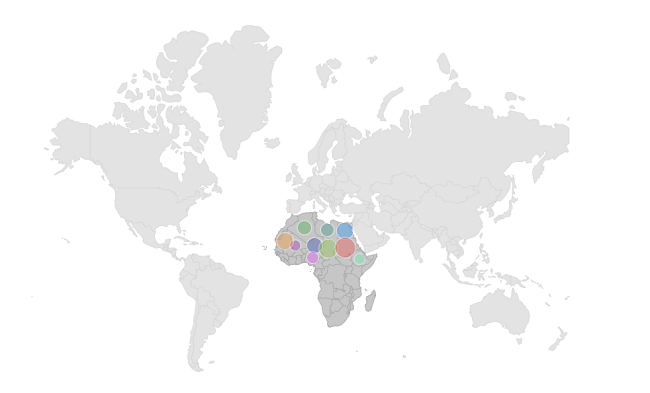
Enable tooltip for shape sublayer
You can enable tooltip for the shape sublayer using the ShowShapeTooltip property.
NOTE
It is applicable for shape layer.
NOTE
Refer the
Tooltipsection to know more about the tooltip customization.
<map:SfMaps>
<map:SfMaps.Layer>
<map:MapShapeLayer ShapesSource="https://cdn.syncfusion.com/maps/map-data/world-map.json">
<map:MapShapeLayer.Sublayers>
<map:MapShapeSublayer ShapesSource="https://cdn.syncfusion.com/maps/map-data/africa.json"
ShapeStroke="DarkGrey"
ShapeFill="#c6c6c6"
ShapeDataField="name"
DataSource="{Binding Data}"
PrimaryValuePath="State"
ShapeColorValuePath="Color"
ShowShapeTooltip="True">
<map:MapShapeSublayer.ShapeTooltipTemplate>
<DataTemplate>
<Grid>
<Grid.RowDefinitions>
<RowDefinition />
<RowDefinition />
</Grid.RowDefinitions>
<Grid.ColumnDefinitions>
<ColumnDefinition />
<ColumnDefinition />
</Grid.ColumnDefinitions>
<Label Text="State:"
TextColor="White"
Grid.Row="0" />
<Label Grid.Row="0"
Grid.Column="1"
Padding="5,0,0,0"
Text="{Binding DataItem.State}"
TextColor="White" />
<Label Text="Population :"
TextColor="White"
Grid.Column="0"
Grid.Row="1" />
<Label Grid.Row="1"
Grid.Column="1"
Padding="5,0,0,0"
Text="{Binding DataItem.Size}"
TextColor="White" />
</Grid>
</DataTemplate>
</map:MapShapeSublayer.ShapeTooltipTemplate>
</map:MapShapeSublayer>
</map:MapShapeLayer.Sublayers>
<map:MapShapeLayer.ZoomPanBehavior>
<map:MapZoomPanBehavior ZoomLevel="2" />
</map:MapShapeLayer.ZoomPanBehavior>
</map:MapShapeLayer>
</map:SfMaps.Layer>
</map:SfMaps>public SelectionUG()
{
InitializeComponent();
ViewModel viewModel = new ViewModel();
this.BindingContext = viewModel;
SfMaps maps = new SfMaps();
MapShapeLayer layer = new MapShapeLayer();
layer.ShapesSource = MapSource.FromUri(new Uri("https://cdn.syncfusion.com/maps/map-data/world-map.json"));
MapZoomPanBehavior zoomPanBehavior = new MapZoomPanBehavior();
zoomPanBehavior.ZoomLevel = 2;
layer.ZoomPanBehavior = zoomPanBehavior;
MapShapeSublayer sublayer = new MapShapeSublayer();
sublayer.ShapesSource = MapSource.FromUri(new Uri("https://cdn.syncfusion.com/maps/map-data/africa.json"));
sublayer.ShapeFill = Color.FromRgb(198, 198, 198);
sublayer.ShapeStroke = Colors.DarkGray;
sublayer.DataSource = viewModel.Data;
sublayer.PrimaryValuePath = "State";
sublayer.ShapeDataField = "name";
sublayer.ShapeColorValuePath = "Color";
sublayer.ShowShapeTooltip = true;
sublayer.ShapeTooltipTemplate = CreateDataTemplate();
layer.Sublayers.Add(sublayer);
maps.Layer = layer;
this.Content = maps;
}
private DataTemplate CreateDataTemplate()
{
return new DataTemplate(() =>
{
var grid = new Grid()
{
RowDefinitions =
{
new RowDefinition (),
new RowDefinition(),
},
ColumnDefinitions =
{
new ColumnDefinition(),
new ColumnDefinition(),
}
};
var stateLabel = new Label
{
TextColor = Colors.White,
Text = "State",
Padding = 5
};
grid.SetRow(stateLabel, 0); grid.SetColumn(stateLabel, 0);
var stateValue = new Label
{
TextColor = Colors.White,
Padding = 5
};
Binding binding = new Binding();
binding.Source = grid.BindingContext;
binding.Path = nameof(MapTooltipInfo.DataItem) + "." + nameof(Model.State);
stateValue.SetBinding(Label.TextProperty, binding);
grid.SetRow(stateValue, 0); grid.SetColumn(stateValue, 1);
var populationLabel = new Label
{
TextColor = Colors.White,
Text = "Population",
Padding = 5
};
grid.SetRow(populationLabel, 1);
grid.SetColumn(populationLabel, 0);
var populationValue = new Label
{
TextColor = Colors.White,
Padding = 5
};
grid.SetRow(populationValue, 2);
grid.SetColumn(populationValue, 2);
Binding binding1 = new Binding();
binding1.Source = grid.BindingContext;
binding1.Path = nameof(MapTooltipInfo.DataItem) + "." + nameof(Model.Size);
populationValue.SetBinding(Label.TextProperty, binding1);
grid.Children.Add(stateLabel);
grid.Children.Add(stateValue);
grid.Children.Add(populationLabel);
grid.Children.Add(populationValue);
return new ViewCell { View = grid };
});
public class ViewModel
{
public ObservableCollection<Model> Data { get; set; }
public ViewModel()
{
Data = new ObservableCollection<Model>();
Data.Add(new Model("Algeria", Color.FromRgb(80, 175, 80), 36232));
Data.Add(new Model("Libya", Color.FromRgb(64, 150, 137), 34121));
Data.Add(new Model("Egypt", Color.FromRgb(48, 150, 243), 43453));
Data.Add(new Model("Mali", Color.FromRgb(157, 59, 176), 28123));
Data.Add(new Model("Niger", Color.FromRgb(63, 81, 181), 40111));
Data.Add(new Model("Nigeria", Color.FromRgb(225, 87, 249), 30232));
Data.Add(new Model("Chad", Color.FromRgb(139, 194, 74), 48132));
Data.Add(new Model("Sudan", Color.FromRgb(238, 79, 79), 52654));
Data.Add(new Model("Mauritania", Color.FromRgb(243, 151, 62), 42231));
Data.Add(new Model("South Sudan", Color.FromRgb(198, 198, 198), 40421));
Data.Add(new Model("Ethiopia", Color.FromRgb(109, 240, 174), 27198));
}
}
public class Model
{
public String State { get; set; }
public Color Color { get; set; }
public double Size { get; set; }
public Model(string state, Color color, double size)
{
State = state;
Color = color;
Size = size;
}
}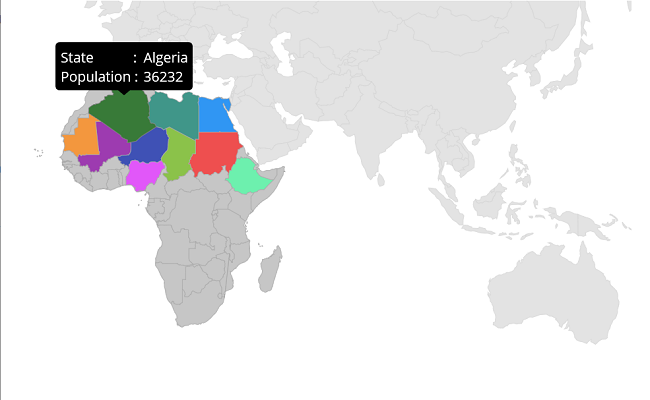
Selection
You can enable shape selection on a map using the EnableSelection property. The Selection allows you to select only one shape at a time. You can select a shape by tapping it. By default, the selection is disabled.
The ShapeSelected event is used to perform any action on shape selected when the user is selects it by tapping or clicking or by programmatically.
NOTE
It is applicable for shape layer.
NOTE
Refer the
Shape selectionsection to know more about the selection feature.
<map:SfMaps>
<map:SfMaps.Layer>
<map:MapShapeLayer ShapesSource="https://cdn.syncfusion.com/maps/map-data/world-map.json">
<map:MapShapeLayer.Sublayers>
<map:MapShapeSublayer ShapesSource="https://cdn.syncfusion.com/maps/map-data/africa.json"
ShapeStroke="DarkGrey"
ShapeFill="#c6c6c6"
ShapeDataField="name"
DataSource="{Binding Data}"
PrimaryValuePath="State"
ShapeColorValuePath="Color"
EnableSelection="True"
SelectedShapeFill="#cddc44"
SelectedShapeStroke="black"
SelectedShapeStrokeThickness="3">
</map:MapShapeSublayer>
</map:MapShapeLayer.Sublayers>
<map:MapShapeLayer.ZoomPanBehavior>
<map:MapZoomPanBehavior ZoomLevel="2" />
</map:MapShapeLayer.ZoomPanBehavior>
</map:MapShapeLayer>
</map:SfMaps.Layer>
</map:SfMaps>public SelectionUG()
{
InitializeComponent();
ViewModel viewModel = new ViewModel();
this.BindingContext = viewModel;
SfMaps maps = new SfMaps();
MapShapeLayer layer = new MapShapeLayer();
layer.ShapesSource = MapSource.FromUri(new Uri("https://cdn.syncfusion.com/maps/map-data/world-map.json"));
MapZoomPanBehavior zoomPanBehavior = new MapZoomPanBehavior();
zoomPanBehavior.ZoomLevel = 2;
layer.ZoomPanBehavior = zoomPanBehavior;
MapShapeSublayer sublayer = new MapShapeSublayer();
sublayer.ShapesSource = MapSource.FromUri(new Uri("https://cdn.syncfusion.com/maps/map-data/africa.json"));
sublayer.ShapeFill = Color.FromRgb(198, 198, 198);
sublayer.ShapeStroke = Colors.DarkGray;
sublayer.DataSource = viewModel.Data;
sublayer.PrimaryValuePath = "State";
sublayer.ShapeDataField = "name";
sublayer.ShapeColorValuePath = "Color";
sublayer.EnableSelection = true;
sublayer.SelectedShapeFill = Color.FromRgb(205, 220, 68);
sublayer.SelectedShapeStroke = Colors.Black;
sublayer.SelectedShapeStrokeThickness = 2;
layer.Sublayers.Add(sublayer);
maps.Layer = layer;
this.Content = maps;
}
public class ViewModel
{
public ObservableCollection<Model> Data { get; set; }
public ViewModel()
{
Data = new ObservableCollection<Model>();
Data.Add(new Model("Algeria", Color.FromRgb(80, 175, 80), 36232));
Data.Add(new Model("Libya", Color.FromRgb(64, 150, 137), 34121));
Data.Add(new Model("Egypt", Color.FromRgb(48, 150, 243), 43453));
Data.Add(new Model("Mali", Color.FromRgb(157, 59, 176), 28123));
Data.Add(new Model("Niger", Color.FromRgb(63, 81, 181), 40111));
Data.Add(new Model("Nigeria", Color.FromRgb(225, 87, 249), 30232));
Data.Add(new Model("Chad", Color.FromRgb(139, 194, 74), 48132));
Data.Add(new Model("Sudan", Color.FromRgb(238, 79, 79), 52654));
Data.Add(new Model("Mauritania", Color.FromRgb(243, 151, 62), 42231));
Data.Add(new Model("South Sudan", Color.FromRgb(198, 198, 198), 40421));
Data.Add(new Model("Ethiopia", Color.FromRgb(109, 240, 174), 27198));
}
}
public class Model
{
public String State { get; set; }
public Color Color { get; set; }
public double Size { get; set; }
public Model(string state, Color color, double size)
{
State = state;
Color = color;
Size = size;
}
}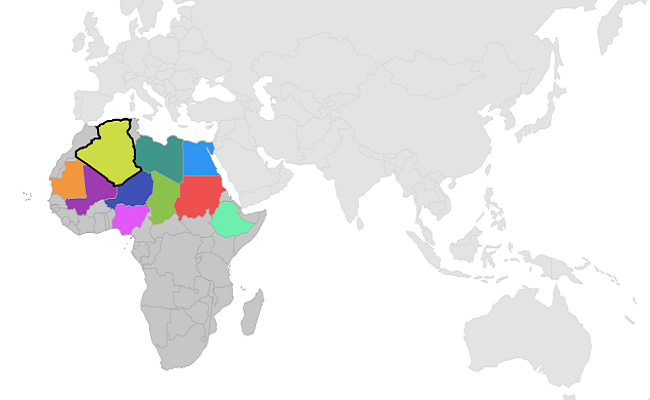
Marker
You can show markers at any position on the map by providing latitude and longitude position to the MapMarker, which is from the Markers collection.
NOTE
It is applicable for both tile layer and shape layer.
NOTE
NOTE
You can refer to our .NET MAUI Maps feature tour page for its groundbreaking feature representations. You can also explore our .NET MAUI Maps Sublayer example that shows how to configure a Maps in .NET MAUI.